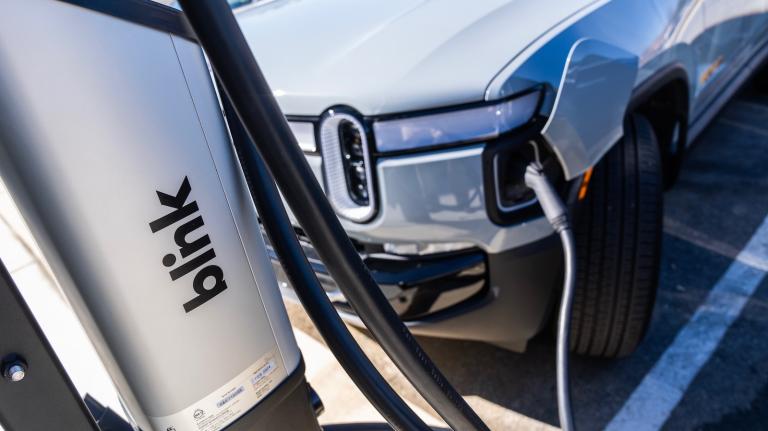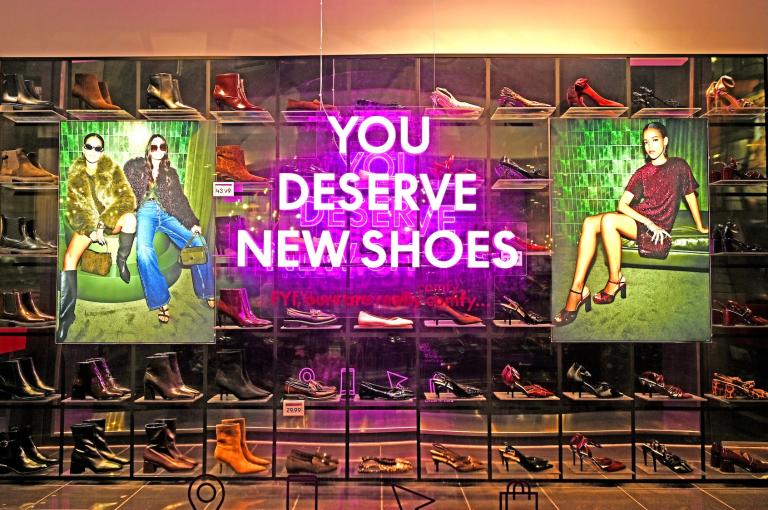Do you realize we are gathered in what must be the greenest building in the United States?” Natural Resources Defense Council Executive Director Frances Beinecke asked a crowd of well-scrubbed Californians gathered for the opening ceremony of the organization’s new SoCal headquarters in Santa Monica. Swilling mimosas and nibbling croissants on the building’s sunny, plant-strewn terrace, everyone cheered and grinned at the rhetorical question, well aware that they were standing at the newest altar of sustainability. I, for one, had sprung for a plane ticket to Santa Monica as though I were heading out on a pilgrimage to the Emerald City.

Redford cutting the green ribbon.
Photo: Gary Leonard, NRDC.
Granted, there was also the allure of hobnobbing with Robert Redford, the man for whom the building was named, thanks to his 28 years of support for NRDC. In his speech at the opening ceremony, Redford bemoaned the “crisis of American leadership … the guiding federal policy of not caring … the nation [being] removed from under our children’s feet … and the Bush administration’s weapons of mass delusion.” But he counterbalanced every grievance with praise for green building and confidence about the clean-technology movement. Speaking with Grist after the ceremony, he called the new NRDC headquarters “a lighthouse of promise and superior environmental engineering … one of the best reasons for optimism at a moment of so much national darkness.” [Editor’s note: Read a recent Grist interview with Robert Redford.]
Truth be told, no one can really verify the claim that the Robert Redford Building is the nation’s greenest structure. Though it is expected to receive the much-coveted Version 2 Platinum green building rating from the U.S. Green Building Council’s Leadership in Energy and Environmental Design (LEED) program, which indicates the highest possible level of sustainable design, the building is just one of several others that may also soon carry this badge. But the claim itself represents a kind of triumph for the sustainable-building movement — a gauntlet, finally, to be thrown down in the spirit of our famously competitive national ethos. It’s about time that the all-American lust for superlatives and habit of one-upmanship be embraced by the building industry — to see not only who can design the tallest and glitziest, but also who can out-green the rest.
“Buildings are far and away the worst thing humans do to the environment,” said Rob Watson, NRDC senior scientist and a chair of the LEED program. “The built environment devours half of all the world’s material and resources, half of all forests. Think about it — the concrete, the drywall, the lumber, steel, vinyl, and granite, not to mention the furniture. Think about all the toxins produced in the mining of materials, the air pollution, the chewed-up land. No other human activity even comes close to this kind of impact.” The most surprising part of this equation is energy: All of the buildings in the U.S. consume more than twice as much energy as all of the cars in the country (when you consider, in BTUs, the total embodied energy it takes to construct and operate them) and emit twice the amount of carbon dioxide — which makes them the leading human-induced cause of global warming. Buildings also consume 80 percent of the nation’s drinking water and 2 million acres of forests and farmland each year.
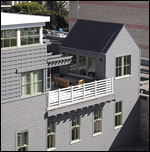
NRDC’s new digs.
Photo: Jean-Maurice
Moulene, Moule &
Polyzoides.
NRDC’s new headquarters, however, uses 60 to 75 percent less energy than a conventional building of its size, gets 100 percent of its energy from carbon-free renewables, and consumes 60 percent less drinking water. As Watson estimated, “If all commercial buildings in the U.S. were as efficient as ours, the country would achieve 70 percent of its Kyoto Protocol obligation.”
In reality, though, only 5 percent of U.S. commercial buildings have begun to integrate clean technology and green principles — largely because the technologies are only just now becoming affordable enough to attract the attention of the mainstream building industry. “I’d estimate that in five years or less, there will be a significant spike in the percentage of buildings that are doing this,” said Ashok Gupta, NRDC’s chief energy economist and director of its air and energy program. “Most of these technologies are becoming off-the-shelf now, and increasingly affordable. It’s just a matter of convincing consumers to demand the technologies and educating developers to continue integrating them in a holistic way.”
Robert Fox is a leading green architect and the man who led the design team for the Conde Nast Building at 4 Times Square, the first high-rise office building in the U.S. to implement clean-technology applications and sustainable principles. He says most developers and architects simply haven’t been able to understand what a vast shift in thinking green building entails: “For most developers, sustainable design is an afterthought; it’s a matter of sticking a solar panel or a windmill on top of the building and calling it green. On the contrary, sustainability must be the defining principle, informing the design and engineering process from the outset of the project.”
Sustainable architecture is about energy efficiency and clean technology, but it’s also about many other things: location, indoor air quality, materials, water consumption, sewage, and ventilation systems. It is about going “beyond standard code requirements to generating ideas that force new efficiencies to emerge,” said Fox.
Location, Location, Location
The NRDC headquarters reads like a case study in how to go about greening the building process. “Even L.A. has never seen a facelift like this,” quipped Alan Horn, president and chief operating officer of Warner Brothers and NRDC board vice chair, in his remarks at the opening ceremony. From the outside, the building looks more like a humble beach bungalow than like the Oz-like dreamscape I was expecting. But on the rooftop, in the basement, and integrated into literally every detail of the building are dozens of examples of sustainable design wizardry.
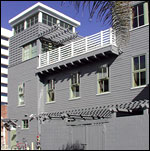
Gray on the outside,
green on the inside.
Photo: Jean-Maurice
Moulene, Moule &
Polyzoides.
According to Elizabeth Moule, the leading architect on the Robert Redford Building, her team’s first consideration was finding an existing, salvageable structure in a downtown location. Rehabilitating an old structure in a developed area is more resource-efficient than building a new one from scratch in an undeveloped area. Moule also serves on the board of directors of the Congress for the New Urbanism, and in the spirit of the movement, she was committed to locating the building in a high-density urban environment close to public transportation and within walking distance of other office, residential, and shopping areas. “New Urbanism is all about walkability,” she said. “The amount of embodied energy and pollution you save when you put your building in a place that people don’t have to drive to is enormous.”
Moule’s second most significant concern was the energy consumption of the building itself. Since lighting is the largest energy drain in standard commercial buildings, her team designed the NRDC headquarters to maximize the amount of daylight it would get, with the result that it is graced by internal courtyards and skylights that illuminate every single office in the building. The few artificial lights are on occupancy sensors and automatically switch off when people step out of a room, and photo sensors dim the lights when daylight is sufficient.
The offices are cooled through natural breezes coming off the ocean — just 100 yards or so from the building. Internal transoms and vents in the roof send hot air upward and out and keep cool air circulating. The windows are designed to block the sun’s short-wave radiation and reduce the amount of solar heat gain in the building, thereby minimizing the need for air conditioning. The design team also used plants and light-colored roofing to absorb and deflect the sunlight, further cutting down on heat gain. When air conditioning is needed, NRDC uses a high-efficiency system with ozone-friendly refrigerants — and it, too, is connected to sensors and shuts down automatically when windows are opened.
All this points to a reality of green building: The moderate climate in Santa Monica makes it far easier to get dramatic energy savings than it would be in cities like New York or Chicago. Nevertheless, technologies are emerging to control energy use in buildings in more extreme climates — such as computerized “smart systems” that automatically track weather forecasts and anticipate changes so they can gradually heat or cool a building. (This is a far more efficient process than letting a building cool down or warm up overnight or during the weekend when extreme weather is in the forecast — and then blasting it with heat or air conditioning when everyone comes back to work.)
Perhaps the most inspiring component of NRDC’s project is its radical pollution-free promise: The Robert Redford Building is one of the first ever constructed in the United States to boast net-zero production of carbon dioxide. Twenty percent of the building’s electricity needs will be supplied by a 7.5 kilowatt solar-electric array on the roof. When the building is empty and not consuming much electricity, the system pumps solar-generated power back into the grid. When the building is at full occupancy and relying on fossil fuel-powered grid energy, NRDC offsets the associated carbon emissions by purchasing an equivalent amount of carbon-free renewable energy (“wind certificates”).
The building’s water savings are also impressive — and particularly important in an area of the country that has insufficient water resources of its own and relies on controversial diversions from the Colorado River. According to Watson, “It’s hard to believe how scarce our drinking water resources are in the grand scheme of things: Less than two-tenths of 1 percent of the planet’s water is drinkable — and more than 80 percent of that goes to uses in buildings, including flushing toilets.” The building’s water-saving strategies include rainwater capture and reuse (which has the added benefit of preventing the runoff from draining into the streets, the municipal sewage system, and the nearby ocean).
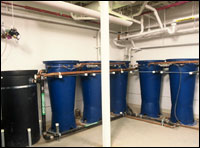
The building’s gray-water
system.
Photo: Grey Crawford, NRDC.
Rainwater and so-called gray water from sinks are treated on site and used for flushing toilets and landscaping. The toilets also have a logical dual-flush option (light or heavy, depending on the amount of waste). Then there are the waterless urinals, which are quickly becoming a mainstream trend with their astounding water and cost savings; each urinal conserves roughly 40,000 gallons of water per year, and cuts down significantly on plumbing bills as well. When I snuck into the men’s bathroom to give the urinals a gander, they looked no different from their conventional counterparts. And though Redford was not there to give a personal review, I detected no unusual odors.
As for building materials, NRDC specified that 98 percent of the wreckage torn down from the original structure be recycled, and chose a number of replacement products with significant recycled content, including carpets and ceiling tiles. Additionally, all the lumber products in the building have been certified by Forest Stewardship Council. Even a majority of the furniture was “recycled” — either donated or bought used in an effort to cut down on the energy used to produce new furnishings.
Other than providing boasting rights, most of these green-building components will have only subtle direct effects on the building’s tenants — with one notable exception: indoor air quality. According to Watson, Americans spend 80 to 90 percent of their time indoors — even those lucky enough to work a stone’s throw from the beach. For most people, that’s bad news, because indoor air quality — what with trapped fumes, carbon dioxide, and particulate matter — can be even worse than outdoor. Not so for the people working in the Robert Redford Building. Its carpeting, paints, and other materials have no or low volatile organic compounds. The copy room is designed with negative pressure, which flushes the ambient toxins generated by the copy machine out of the building. Carbon dioxide sensors determine when extra fresh air is required — a particular concern from a worker-productivity standpoint, because an excess of CO2 in poorly ventilated offices and conference rooms causes drowsiness.
Follow Our LEED
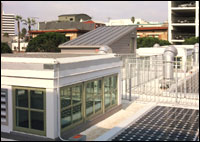
Putting the California sun to
work.
Photo: Grey Crawford, NRDC.
Given the implications of the amazing resource efficiency of the new NRDC building, it seems absurd, from a policy standpoint, that green building is so overlooked. Why isn’t creating incentives for efficient buildings as much of a policy priority as, say, creating incentives and funding research for more efficient cars? “There is simply a fundamental disconnect between buildings and their hidden consequences,” said Watson. “Most people don’t realize that when we talk about clear cutting, we’re talking about buildings. When we talk about power plants, mining, drought, and global warming, we’re talking about buildings.”
But some people do realize it, of course, and a clamor for green buildings is starting to make itself heard on local, state, and federal levels. Already, cities ranging from the usual suspects (Seattle, Berkeley, and Portland, Ore.) to less predictable locations (San Jose, Austin, and Arlington, Va.) have created funds and incentives to help promote green building development; some even require that all new government buildings be LEED certified. Movements are also afoot in larger cities, including New York and San Francisco, to require municipal buildings to meet LEED standards. On a state level, Maryland, New Jersey, New York, and Pennsylvania have introduced green-building incentives and requirements.
The federal government is making progress, too; U.S. government buildings account for roughly 10 percent of the projects registered in the LEED program. The Department of Defense has adopted LEED standards for all new Navy, Army, and Air Force buildings, and the U.S. EPA and NASA have both instituted LEED Silver rating goals for all major new facilities. Other agencies, such as the Department of Energy, State Department, and Department of Health and Human Services, have also begun to set green-building goals.
Still, none of these plans is sufficiently ambitious. Particularly given the absence of federal global-warming legislation, there should be a government-wide initiative mandating that all agencies achieve high-level LEED certification for all new facilities. “Now that these programs are proving effective from both an environmental and economic standpoint, it’s clearly time to redouble the effort to expand them to more and more cities, states, and federal agencies,” said Watson.
And yet, as Gupta noted, LEED considers itself first and foremost a market-based effort and emphasizes economic pragmatism over incentives and regulations. “What’s amazing about LEED is how much it has become the brand developers seek out because it gives cache to their projects,” he said. “Our primary focus is on how we can get people to demand it in the marketplace. We want people renting buildings to say: ‘Are you LEED certified?’ And developers have less and less reason not to be, given that it makes so much economic and environmental sense.”
Indeed, the state of California recently came out with a study comparing the cost of 40 green buildings — most of them LEED certified — to conventional buildings and found that, on average, the initial costs of green buildings were only 2 percent higher, and the long-term benefit-to-cost ratio was 10 to 1. Furthermore, said Gupta, the nearly 5 percent of developers who have begun adopting green principles is actually a considerable quantity, given that “the early adopters pave the way for mainstream adopters, streamlining the certification process and creating economies of scale that reduce costs.”
So once the early adopters push the movement to a tipping point, the logic goes, it will be a landslide. In addition to incentives and regulations, perhaps the best way to nudge this tipping point would be to launch a “Greenest Building on the Planet” competition — a race to develop an ever bigger symbol of optimism, an ever higher altar of sustainability. Right now that title belongs to a building in India — the Sohrabji Godrej Green Business Centre in Hyderabad, which was the first building in the world to receive the LEED Platinum rating. There’s a chance that the Robert Redford Building will beat out this rating (the jury is still out) — but if it doesn’t, let’s challenge American developers to come up with another project that does. This is one form of American supremacy, surely, that we can all support.

